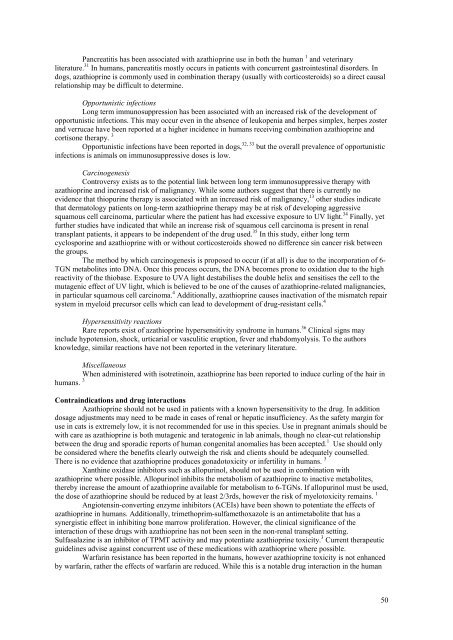Azathioprine and chlorambucil: mechanism of action and use in ...
Azathioprine and chlorambucil: mechanism of action and use in ...
Azathioprine and chlorambucil: mechanism of action and use in ...
Create successful ePaper yourself
Turn your PDF publications into a flip-book with our unique Google optimized e-Paper software.
Pancreatitis has been associated with azathiopr<strong>in</strong>e <strong>use</strong> <strong>in</strong> both the human 1 <strong>and</strong> veter<strong>in</strong>ary<br />
literature. 31 In humans, pancreatitis mostly occurs <strong>in</strong> patients with concurrent gastro<strong>in</strong>test<strong>in</strong>al disorders. In<br />
dogs, azathiopr<strong>in</strong>e is commonly <strong>use</strong>d <strong>in</strong> comb<strong>in</strong>ation therapy (usually with corticosteroids) so a direct causal<br />
relationship may be difficult to determ<strong>in</strong>e.<br />
Opportunistic <strong>in</strong>fections<br />
Long term immunosuppression has been associated with an <strong>in</strong>creased risk <strong>of</strong> the development <strong>of</strong><br />
opportunistic <strong>in</strong>fections. This may occur even <strong>in</strong> the absence <strong>of</strong> leukopenia <strong>and</strong> herpes simplex, herpes zoster<br />
<strong>and</strong> verrucae have been reported at a higher <strong>in</strong>cidence <strong>in</strong> humans receiv<strong>in</strong>g comb<strong>in</strong>ation azathiopr<strong>in</strong>e <strong>and</strong><br />
cortisone therapy. 3<br />
Opportunistic <strong>in</strong>fections have been reported <strong>in</strong> dogs, 32, 33 but the overall prevalence <strong>of</strong> opportunistic<br />
<strong>in</strong>fections is animals on immunosuppressive doses is low.<br />
Carc<strong>in</strong>ogenesis<br />
Controversy exists as to the potential l<strong>in</strong>k between long term immunosuppressive therapy with<br />
azathiopr<strong>in</strong>e <strong>and</strong> <strong>in</strong>creased risk <strong>of</strong> malignancy. While some authors suggest that there is currently no<br />
evidence that thiopur<strong>in</strong>e therapy is associated with an <strong>in</strong>creased risk <strong>of</strong> malignancy, 13 other studies <strong>in</strong>dicate<br />
that dermatology patients on long-term azathiopr<strong>in</strong>e therapy may be at risk <strong>of</strong> develop<strong>in</strong>g aggressive<br />
squamous cell carc<strong>in</strong>oma, particular where the patient has had excessive exposure to UV light. 34 F<strong>in</strong>ally, yet<br />
further studies have <strong>in</strong>dicated that while an <strong>in</strong>crease risk <strong>of</strong> squamous cell carc<strong>in</strong>oma is present <strong>in</strong> renal<br />
transplant patients, it appears to be <strong>in</strong>dependent <strong>of</strong> the drug <strong>use</strong>d. 35 In this study, either long term<br />
cyclospor<strong>in</strong>e <strong>and</strong> azathiopr<strong>in</strong>e with or without corticosteroids showed no difference s<strong>in</strong> cancer risk between<br />
the groups.<br />
The method by which carc<strong>in</strong>ogenesis is proposed to occur (if at all) is due to the <strong>in</strong>corporation <strong>of</strong> 6-<br />
TGN metabolites <strong>in</strong>to DNA. Once this process occurs, the DNA becomes prone to oxidation due to the high<br />
reactivity <strong>of</strong> the thiobase. Exposure to UVA light destabilises the double helix <strong>and</strong> sensitises the cell to the<br />
mutagenic effect <strong>of</strong> UV light, which is believed to be one <strong>of</strong> the ca<strong>use</strong>s <strong>of</strong> azathiopr<strong>in</strong>e-related malignancies,<br />
<strong>in</strong> particular squamous cell carc<strong>in</strong>oma. 4 Additionally, azathiopr<strong>in</strong>e ca<strong>use</strong>s <strong>in</strong>activation <strong>of</strong> the mismatch repair<br />
system <strong>in</strong> myeloid precursor cells which can lead to development <strong>of</strong> drug-resistant cells. 4<br />
Hypersensitivity re<strong>action</strong>s<br />
Rare reports exist <strong>of</strong> azathiopr<strong>in</strong>e hypersensitivity syndrome <strong>in</strong> humans. 36 Cl<strong>in</strong>ical signs may<br />
<strong>in</strong>clude hypotension, shock, urticarial or vasculitic eruption, fever <strong>and</strong> rhabdomyolysis. To the authors<br />
knowledge, similar re<strong>action</strong>s have not been reported <strong>in</strong> the veter<strong>in</strong>ary literature.<br />
Miscellaneous<br />
When adm<strong>in</strong>istered with isotret<strong>in</strong>o<strong>in</strong>, azathiopr<strong>in</strong>e has been reported to <strong>in</strong>duce curl<strong>in</strong>g <strong>of</strong> the hair <strong>in</strong><br />
humans. 3<br />
Contra<strong>in</strong>dications <strong>and</strong> drug <strong>in</strong>ter<strong>action</strong>s<br />
<strong>Azathiopr<strong>in</strong>e</strong> should not be <strong>use</strong>d <strong>in</strong> patients with a known hypersensitivity to the drug. In addition<br />
dosage adjustments may need to be made <strong>in</strong> cases <strong>of</strong> renal or hepatic <strong>in</strong>sufficiency. As the safety marg<strong>in</strong> for<br />
<strong>use</strong> <strong>in</strong> cats is extremely low, it is not recommended for <strong>use</strong> <strong>in</strong> this species. Use <strong>in</strong> pregnant animals should be<br />
with care as azathiopr<strong>in</strong>e is both mutagenic <strong>and</strong> teratogenic <strong>in</strong> lab animals, though no clear-cut relationship<br />
between the drug <strong>and</strong> sporadic reports <strong>of</strong> human congenital anomalies has been accepted. 1 Use should only<br />
be considered where the benefits clearly outweigh the risk <strong>and</strong> clients should be adequately counselled.<br />
There is no evidence that azathiopr<strong>in</strong>e produces gonadotoxicity or <strong>in</strong>fertility <strong>in</strong> humans. 3<br />
Xanth<strong>in</strong>e oxidase <strong>in</strong>hibitors such as allopur<strong>in</strong>ol, should not be <strong>use</strong>d <strong>in</strong> comb<strong>in</strong>ation with<br />
azathiopr<strong>in</strong>e where possible. Allopur<strong>in</strong>ol <strong>in</strong>hibits the metabolism <strong>of</strong> azathiopr<strong>in</strong>e to <strong>in</strong>active metabolites,<br />
thereby <strong>in</strong>crease the amount <strong>of</strong> azathiopr<strong>in</strong>e available for metabolism to 6-TGNs. If allopur<strong>in</strong>ol must be <strong>use</strong>d,<br />
the dose <strong>of</strong> azathiopr<strong>in</strong>e should be reduced by at least 2/3rds, however the risk <strong>of</strong> myelotoxicity rema<strong>in</strong>s. 1<br />
Angiotens<strong>in</strong>-convert<strong>in</strong>g enzyme <strong>in</strong>hibitors (ACEIs) have been shown to potentiate the effects <strong>of</strong><br />
azathiopr<strong>in</strong>e <strong>in</strong> humans. Additionally, trimethoprim-sulfamethoxazole is an antimetabolite that has a<br />
synergistic effect <strong>in</strong> <strong>in</strong>hibit<strong>in</strong>g bone marrow proliferation. However, the cl<strong>in</strong>ical significance <strong>of</strong> the<br />
<strong>in</strong>ter<strong>action</strong> <strong>of</strong> these drugs with azathiopr<strong>in</strong>e has not been seen <strong>in</strong> the non-renal transplant sett<strong>in</strong>g.<br />
Sulfasalaz<strong>in</strong>e is an <strong>in</strong>hibitor <strong>of</strong> TPMT activity <strong>and</strong> may potentiate azathiopr<strong>in</strong>e toxicity. 3 Current therapeutic<br />
guidel<strong>in</strong>es advise aga<strong>in</strong>st concurrent <strong>use</strong> <strong>of</strong> these medications with azathiopr<strong>in</strong>e where possible.<br />
Warfar<strong>in</strong> resistance has been reported <strong>in</strong> the humans, however azathiopr<strong>in</strong>e toxicity is not enhanced<br />
by warfar<strong>in</strong>, rather the effects <strong>of</strong> warfar<strong>in</strong> are reduced. While this is a notable drug <strong>in</strong>ter<strong>action</strong> <strong>in</strong> the human<br />
50
















